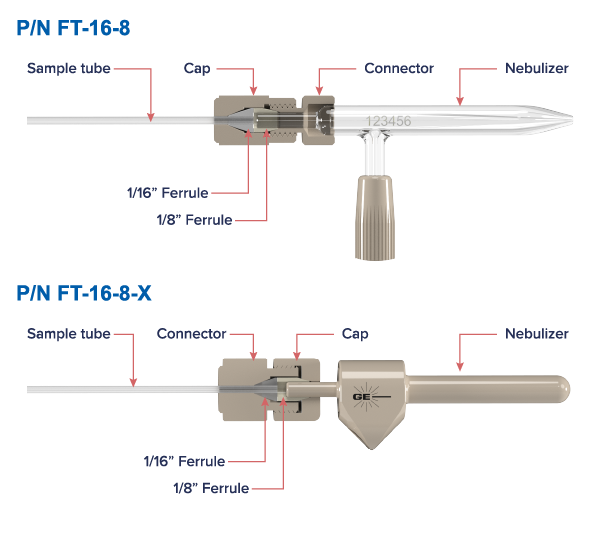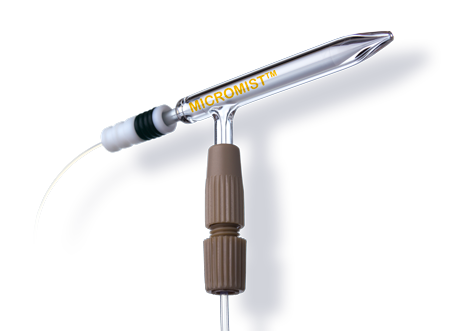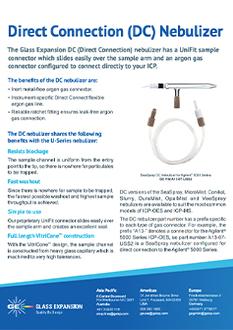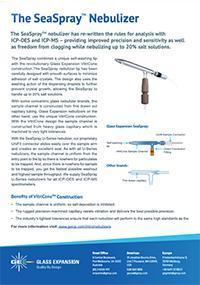Features of the MicroMist™ DC Nebulizer
The MicroMist micro-uptake glass concentric nebulizer offers high performance for limited sample volumes. It makes routine ICP-MS Hg determinations possible and reduces matrix effects when used with Glass Expansion's Cinnabar spray chamber.
- Material: Borosilicate glass
- High physical reproducibility ~ 1%
- TDS tolerance, typically up to 15%
- Highest transport efficiency
- Low RSD's due to highly accurate construction
- Standard available uptake: 0.05, 0.1, 0.2, 0.4, 0.5 & 0.6mL/min

Design Features
VitriCone™ Sample Channel
- Proprietary sample channel is guaranteed uniform from entry point to nebulizer tip and thus resistant to clogging.
- Rugged precision-machined borosilicate glass capillary resists vibration and delivers the best possible precision.
- Industry's tightest tolerances ensure that each nebulizer will perform to the same high standards as the previous one, physical reproducibility within 1%.

UniFit™ Sample Connector
- Slides easily over the sample arm creating an excellent insert seal and provides a zero-dead volume sample connection.
- A zero-dead volume connection ensures the fastest washout and highest sample throughput, since there is nowhere for the sample to be trapped.
Direct Connection (DC) Gas Line
- Inert metal-free argon gas connector.
- Reliable ratchet fitting ensures leak-free nebulizer gas connection.
- Instrument-specific Direct Connect flexible argon gas line (click here for the DC video installation guide).
The DC nebulizer part number has a prefix specific to each type of gas connector. For example, the prefix "A13-" denotes a connector for the Agilent® 7700/7800/7850/7900/8800/8900, so part number A13-1-UM04X is a MicroMist DC nebulizer configured for direct connection to the Agilent® ICP-MS 7700/7800/7850/7900/8800/8900. (Click here for a full list of available DC gas connectors).
Performance
Enhanced Efficiency
Although the MicroMist nebulizer operates at a lower sample flow rate, the transport efficiency is significantly higher compared to a standard concentric nebulizer. The graph illustrates the relationship between uptake rate and nebulizer efficiency (the percentage of the sample that reaches the plasma as opposed to going down the drain).

At 50 µL/min, the MicroMist has a 50% efficiency and therefore injects 25 µL/min into the plasma. On the other hand, a standard 2 mL/min concentric nebulizer has a 2% efficiency, resulting in 40 µL/min of sample injected into the plasma. This means that the MicroMist nebulizer can reduce sample consumption by a factor of 40, and yet the sensitivity is reduced by less than a factor of two. For this reason, the MicroMist is the first choice for applications with limited sample volumes.
A sample uptake rate for every low-flow application
With a strong and consistent self-aspiration, the MicroMist nebulizers can be used with or without a peristaltic pump. The MicroMist product line includes models with natural sample uptake rates of 50, 100, 200, 400 and 600 µL/min. When choosing a MicroMist nebulizer, select the model that most closely matches your desired sample flow rate. It is always OK to starve a nebulizer, but you should not exceed the natural sample uptake rate. Need help choosing the best option? contact enquiries@geicp.com for help.
Reduced Interferences
The smaller droplet size of the MicroMist nebulizer has additional analytical advantages, including reduced matrix interferences and a more robust plasma.
Tolerance to High Matrix
Although the MicroMist nebulizer is a low-flow nebulizer, it still provides a relatively high tolerance to total dissolved solids (TDS) at 15%. Providing the ability to handle a wide range of sample types, including challenging samples such as waste water, soil, blood, serum, and urine. For the enhanced tolerance to TDS consider adding an argon humidifier, such as our Elegra.
Recommended Applications
- Any ICP-OES and ICP-MS application demanding the highest transport efficiency and precision.
- Samples with limited volume, such as biological samples.
- Samples of high value, such as precious metals and fine chemicals.
- Hazardous or radioactive that are difficult to dispose of.
- Any organics and highly volatile organics that are challenging due to plasma instability.
- Isotope ratio and single-event ICP-MS (single-cell, single particle, and nanoparticle) analysis, where precision and efficiency are critical. Applications requiring the highest sensitivity and precision, such as toxic metals in cannabis.
Common Accessories
Nexus™ Universal Nebulizer Connection Kit
Speciation is a technique often coupled with ICP-MS. Glass Expansion's Nexus Universal Nebulizer Connection Kit provides a reliable means of directly connecting the output capillary from an HPLC or LC to the MicroMist DC nebulizer. In combination with the VitriCone capillary of the MicroMist, this provides a zero-dead volume high-pressure interface, eliminating the chance of peak broadening due to dead volume. The Nexus Universal Nebulizer Connection Kit can also be used with precision syringe delivery systems to provide improved stability of sample delivery to the MicroMist nebulizer.
| Part Number | Description |
|
FT-16-8
|
Nexus™ Universal Connection Kit for all Glass Concentric U-Series or DC nebulizers |
|
FT-16-8-X
|
Nexus™ Universal Connection Kit for Inert nebulizers |

Ordering Information
Find a MicroMist™ nebulizer to suit your ICP-MS or ICP-OES:
| Manufacturer | Model |
| Agilent® | 5100, 5110, 5800, 5900 |
| Agilent® |
8900 |
| Agilent® |
7900 |
| Agilent® |
7800, 7850
|
| Agilent® |
7700, 8800 |
| Analytik Jena |
PlasmaQuant MS Series
|
| Perkin Elmer® | Avio 200, 500 Series |
| Perkin Elmer® |
NexION 5000
|
| Perkin Elmer® | NexION 1000, 1100, 2000 |
| Perkin Elmer® | NexION 300, 350 |
| Shimadzu® | ICPM-8500, ICPMS-2030 |
| Thermo Scientific™ |
PRO DUO |
| Thermo Scientific™ |
PRO Radial |
| Thermo Scientific™ |
Q, RQ, TQ |
| Thermo Scientific™ |
Neoma MC-ICP-MS |
Related Documents
GE Mailing List
Please complete this form to subscribe to the latest Glass Expansion Newsletter.
Thank you
You are now subscribed to the Glass Expansion mailing list.



Customer Comments